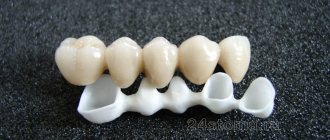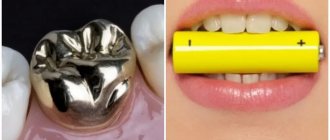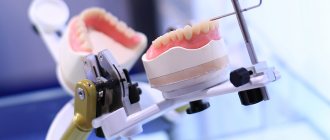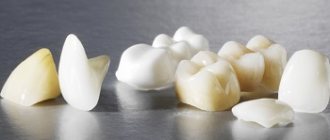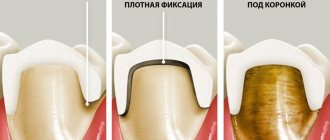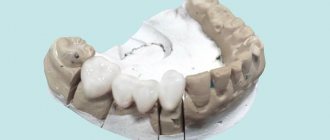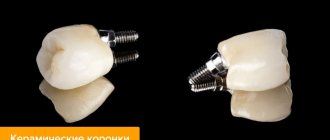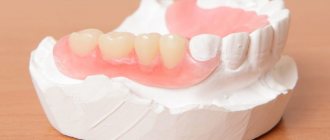To make temporary crowns, dentists use self-hardening types of plastic that do not require polymerization. This material of the orthodontic product does not have a negative effect on the oral cavity. Can polymerize under the temperature of the human body and dental office.
Plastic crowns are made in a short period of time, their cost is lower than products made from other materials. Therefore, they are the best option in case of emergency tooth injury and lack of the necessary amount of money for its restoration.
When are temporary crowns used?
The installation of such orthodontic structures is recommended by the dentist in the following cases:
- minor defect in the dentition. Installing a temporary crown will help eliminate the unhealthy color of the element or its irregular shape in order to maintain the normal appearance of the dentition,
- waiting for the production of a permanent prosthesis,
- preventing infection of dental tissues after grinding and displacement of adjacent elements,
- exclusion of fusion of the gum bed, if the patient has not decided on the choice of further type of treatment,
- installation of a splint for periodontal disease. A plastic crown normalizes problems with diction,
- creating support elements to hold removable products in order to properly distribute the chewing load,
- violation of tooth integrity more than 50%.
It is worth remembering that the following contraindications exist:
- age up to 12 years,
- bite too deep
- presence of bruxism,
- inflammation of the gum or tooth tissue at the installation site,
- allergic reaction to plastic,
- neurological and mental disorders.
Plastic is highly porous, so if you are not particularly careful about hygienic oral care, you should avoid installing this type of structure.
Temporary dentures for the front teeth
If the absence of lateral teeth can still go unnoticed, then the absence of at least one front tooth, especially in the upper jaw, immediately catches the eye when communicating.
Making permanent crowns takes about 10 days, so during this period the ground teeth are replaced with temporary crowns made of plastic or acrylic.
These materials are not suitable for long-term wear, as their quality is much lower than that of their permanent counterparts.
However, they do their job perfectly well for a period of 2-4 weeks. Provisional crowns, as they are also called, are needed not only to hide the defect (and the ground tooth does not look the best), but also to protect against the influence of the external environment (temperature, food plaque, acids).
Do not wear temporary crowns longer than the period specified by your doctor, as they will quickly lose their original properties.
Plastic is stained by drinks and food with coloring pigments, and pathogenic microorganisms can penetrate its porous structure and cause inflammation.
How are temporary crowns made?
The creation of plastic orthodontic products can take place both in the dental office (direct method) and in a special dental laboratory (indirect method). Moreover, in the second option the design is considered to be of higher quality and more reliable.
There are stages of making crowns by a dentist:
- taking a silicone or plastic impression from the tooth, which will subsequently serve as a form for making a temporary structure,
- preparation of the element to create space for the crown. When treating single-rooted teeth, it will be necessary to perform depulpation to avoid burns of the pulp and damage to the tooth tissue. In the case of prosthetics of masticatory elements, it is possible to do without depulpation, but then anesthesia will be required,
- polymerization of plastic. A mixture prepared from an acrylic plastic solution and polymerizing powder is poured into the resulting impression and placed on the tooth.
- in a few minutes it hardens, and then the impression is removed from the oral cavity, and the resulting plastic prosthesis remains on the element of the dentition,
- carry out grinding and polishing of the product,
- Fixation is carried out with a cementing solution on the ground tooth.
To read: How long can you keep arsenic in your tooth?
With this manufacturing method, the orthodontic device is worn for no more than 1-2 months. If longer wearing is required, you must wait until the crown is created in a dental laboratory:
- silicone impressions of the upper and lower jaw are made,
- A plaster model is created based on the shape of the casts. It is on this that the product is then adjusted,
- model a product from wax,
- make a plastic crown,
- the structure is ground and polished,
- installation of the product on the prepared tooth and fixation with a cementing solution.
Before placing a temporary prosthesis, it is necessary to thoroughly sanitize the oral cavity, remove plaque and stones affected by the carious process of tissues. If necessary, replace old fillings. These procedures will help increase the life of the orthodontic structure.
Classification:
By purpose:
- Restorative;
- Abutment (used in bridges ; they replace not only a defect within the coronal part of a tooth, but also a missing tooth or several teeth).
By design features:
- Full (cover the prepared stump from all sides), partial (three-quarter, half-crowns) leave the outer surface of the crown open;
- Telescopic (double; used in removable prosthetics, the first cone-shaped is fixed on the stump, the second, restoring the tooth, is part of the removable part and is put on the first).
According to the material used:
- Metal (noble or base alloys);
- Non-metallic (ceramics, zirconium dioxide, plastic, composite);
- Combined (metal-ceramics, metal-plastic).
By fixation method:
- Cemented (for prosthetics of natural teeth or on implants);
- Screw (used only for prosthetics on implants - artificial analogues of natural roots, strengthened inside the bone tissue of the jaws).
By service life:
- Permanent;
- Temporary - provisional (used at the stages of manufacturing the final ones to protect the stump from irritants, restore contacts with other teeth and for aesthetic purposes, including to form the contour of the gums ).
What types of plastic are used?
Self-hardening plastics have gained great popularity in dentistry for the manufacture of temporary crowns due to their rapid hardening at room temperature. They are also capable of freezing at the temperature of the human body. This greatly simplifies the process of manufacturing temporary structures and reduces its time.
Polymerization occurs due to the initiating effect of the initiator-activator system, in which the first component is benzoyl peroxide, and the second is demethylparatoluidine.
The following types of fast-hardening cold polymerization plastics are used:
- Protacryl. It is a pink powder containing benzoyl peroxide, polymethyl methacrylate and disulfanamine. The presence of two activators allows the hardening process to reach the final result in 15-20 minutes,
- Redont. Available as a translucent pink powder and liquid,
- Stadont, powder-liquid acrylic plastic. The Stadont kit includes 3 types of powder in different colors,
- Acrylic oxide is a white plastic made from acrylic and epoxy resin. The set includes 3 powders and a liquid,
- Carboplast. It contains chalk. In dough-like form, it is distributed over the plaster model in an even layer and quickly hardens while on it.
Unlike hot-curing plastics, these types do not require heating equipment, and the size of the resulting product undergoes fewer changes. Their disadvantage is their low strength compared to hot-curing plastics.
Advantages and disadvantages
The advantages of temporary crowns made of plastic include the following properties:
- creation speed. Plastic is easy to process, so you can make a crown out of it in a short period of time,
- High aesthetics lies in the ability to select the shape and shade to match the color of natural teeth. They are not transparent enough compared to ceramic products, but they are quite suitable for temporary installation,
- affordable cost of orthodontic construction,
- excellent biocompatibility with tissues of the dentition element,
- minimum degree of tooth grinding during installation,
- plasticity of the material,
- ease of installation and maintenance,
- possibility of design adjustments,
- no pain while eating food,
- does not have negative effects on enamel,
- restoration of chewing function of teeth.
To read: Vomiting during teething
Disadvantages of the product:
- low strength, i.e. there is a high risk of breakage due to a fall or impact,
- increased abrasion can cause injury to the gums and the development of an inflammatory process,
- yellowing of the material over time or the appearance of stains on it,
- the porosity of plastic threatens the accumulation of bacteria, which will lead to the formation of tartar and caries,
- short period of operation,
- the possibility of allergic reactions to the material of the product.
That is why plastic types of prostheses should be used only in the case of temporary prosthetics.
Advantages of artificial crowns:
If all conditions are met, the possible disadvantages of this design (for example, bleeding, temporary whitening or a feeling of pressure in the area of the adjacent gum) are mild or completely absent. However, it should be understood that while performing a restorative and, to a certain extent, preventive function, orthopedic treatment does not affect the main cause of caries - the acid produced by plaque microorganisms. This means that daily personal oral hygiene measures must be carried out in full.
Each type of crown is characterized by its own manufacturing technology: metal ones are cast or stamped, plastic and composite ones are polymerized, ceramic ones are sintered, pressed, milled. Those previously used (stamped with plastic lining, partial, metal-plastic) are now rarely used. Despite this circumstance, at the present stage of development there is a sufficient variety of options to find the optimal solution in each case.
The choice of material and technology depends on the objectives of the individual clinical situation.
How long do temporary crowns last?
If the prosthesis is installed while waiting for the production of a permanent structure, then it is installed for 5-14 days. The maximum service life of a crown made in a dental office is 1-2 months.
When creating a product in a laboratory, the service life is 2-3 years.
It should be taken into account that the following factors can reduce the service life:
- insufficient care of the structure and oral cavity. Due to its porosity, plastic gradually swells and changes color, which creates some discomfort and requires replacement of the product,
- Due to the fragility of the material, high chewing load and strong mechanical impact can lead to chips and breakage of the prosthesis.
Proper and careful maintenance will help maintain the integrity of the structure until it is replaced.
Do you feel nervous before visiting the dentist?YesNo
A laboratory technician performs the following manipulations:
In addition to the traditional manufacturing method, there is also the so-called milling from ready-made blocks on a computer-controlled machine (CAD/CAM technology, for example CEREC, EVEREST). Using an optical system, an impression is taken (essentially scanned) either of the prepared area directly in the oral cavity, or of a model, then the data is transferred to a computer, where the image is processed by a special program, a model of the future restoration is built, which can be corrected, and then sharpened and finalized ( painted and glazed to give a shine comparable to natural). Now this is the most accurate way to create structures of various sizes and lengths (up to the entire dental arch), because human involvement and therefore possible inaccuracies are reduced to a minimum. The next step will obviously be the development of 3D printing technologies.
{SOURCE}
How are temporary crowns installed?
There are 2 main methods for installing temporary prostheses:
- in the dental office. A silicone impression is taken from the problematic element. The tooth is ground and, if necessary, depulped and filled. If the nerve does not need to be removed, an injection of anesthesia is necessary. The prepared plastic mass is poured into the impression and placed on the tooth. After it hardens, the impression is removed and the crown is fixed with a cementing solution. Then it is sanded and polished,
- installation of a pre-prepared temporary prosthesis. The product is delivered from the dental laboratory to the dentist, who places it on the patient's prepared tooth during the follow-up appointment. Fixation is carried out in the same way as in the previous case.
General sequence of clinical and laboratory stages of manufacturing artificial crowns
Several specialists take part in their creation:
- Orthopedic dentist (carries out diagnostics, design planning, consultation, preparation of teeth for prosthetics - odontopreparation, taking impressions, quality control of the construction at all stages with correction if necessary, fitting, temporary and permanent fixation, dispensary observation - periodic examinations);
- Dental technician (together with the doctor, plans the future design and carries out its direct production on models (plaster analogues of teeth and jaws, obtained from impressions) in the laboratory, makes adjustments, if any);
- Dental assistant – performs auxiliary manipulations in the oral cavity and office during treatment.
Stage 1:
- Diagnostic – basic (questioning, i.e. medical history, examination) and additional (usually one of the types of x-ray examination) examination methods, drawing up and agreeing on a treatment plan, impressions for diagnostic models and temporary crowns , preliminary determination of color, bite registration . If necessary, auxiliary measures are carried out - a complex of professional hygiene (removal of dental plaque), treatment or re-treatment of caries (replacement of old restorations), endodontic (pulp removal, re-treatment of the root canal system) or surgical (lengthening of the clinical, i.e. visible crown with insufficient height). In a difficult clinical situation, total prosthetics, a special device is used - a face bow , which fixes the position of the upper jaw in the space of the skull and makes it possible to transfer it to a device that reproduces the natural movements of the lower jaw - an articulator. A dental photography protocol is also used - registration of images of the patient’s face in front and in profile, dentition in a closed and open state in the anterior and lateral sections. This manipulation helps the technician in choosing the visual characteristics of the future restoration (building a color scheme for the restoration, determining its size and shape).
Stage 2
- Preparatory – odontopreparation – grinding of hard tissues to create the shape of the tooth stump, providing the possibility of applying and subsequent fixation of the structure, as well as ensuring the correct relationship between the edge of the crown and the soft tissues of the gums. During this manipulation on living teeth, water-air cooling in order to prevent overheating of the hard tissues of the tooth. Taking working impressions, final color determination. Fitting, correction (relining) and temporary fixation of temporary crowns.
Stage 3
- Final – delivery of the work (trying on and, if necessary, correction of the structure, agreement with the patient on the coincidence of the existing and desired results regarding color, shape, size, convenience, temporary (for combined) or permanent (for metal-free structures) fixation; subsequent replacement of the temporary fixation with a permanent one) .
Care
Basic care rules to ensure the long life of an orthodontic product:
- twice daily cleansing of the oral cavity with a soft brush and paste. In this case, the installation site of the crown must be treated with special care,
- rinsing your mouth after eating,
- use dental floss, irrigators or brushes to remove food grains from the interdental space,
- try not to touch the teeth of the upper and lower jaw too tightly,
- Do not eat viscous or too hard foods, especially avoid biting them. When taking them, the chewing load must be shifted to the other side,
- If the product is chipped or broken, contact your dentist as soon as possible.
